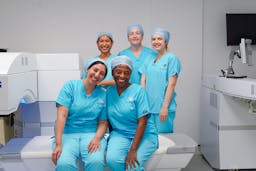
LASEK (Laser Epithelial Keratomileusis) eye surgery is a refractive surgery procedure designed to correct vision problems, particularly nearsightedness, farsightedness, and astigmatism. The history of LASEK is closely tied to the development of other laser eye surgery techniques, particularly PRK (Photorefractive Keratectomy) and LASIK (Laser-Assisted In Situ Keratomileusis). LASEK was introduced as a modification of PRK, aiming to address certain issues associated with the latter.
The concept of reshaping the cornea using laser technology to improve vision began in the 1980s. PRK, the precursor to LASEK, involved the removal of the corneal surface tissue (epithelium) before laser ablation. However, the prolonged recovery time and discomfort associated with PRK led to the development of LASEK in the late 1990s. Dr. Massimo Camellin, an Italian ophthalmologist, is credited with introducing LASEK as a less invasive alternative to PRK. LASEK retained the benefits of surface ablation while preserving more of the corneal tissue, resulting in a quicker recovery compared to PRK.
LASEK gained popularity as a viable option for individuals seeking laser eye surgery with reduced postoperative discomfort. It has since become one of the choices alongside LASIK and PRK, offering patients an alternative based on their specific needs and eye conditions. The evolution of LASEK reflects the continuous refinement and innovation in the field of refractive surgery, contributing to improved outcomes and patient satisfaction.
The Technology Behind LASEK Surgery
LASEK surgery involves the use of advanced laser technology and precise instruments to reshape the cornea and correct vision problems. The key equipment used in LASEK surgery includes:
Excimer Laser
The excimer laser is the primary tool used in LASEK surgery to reshape the cornea. This type of laser emits a cool ultraviolet light that precisely removes microscopic amounts of corneal tissue without generating heat. The laser is programmed based on the patient's specific prescription, allowing for accurate correction of refractive errors.

Microkeratome or Trephine
In LASEK, a microkeratome or trephine is used to create a thin flap in the corneal epithelium, which is then gently lifted to expose the underlying corneal tissue for laser ablation. This differs from LASIK, where a deeper flap is created. The precision of the microkeratome or trephine is crucial in ensuring a controlled and accurate procedure.
Alcohol Solution
Before the corneal flap is created, an alcohol solution is often applied to loosen the epithelial cells. This facilitates the easy lifting of the flap, allowing access to the corneal stroma for laser treatment.
Cooling and Irrigation Systems
During the laser ablation process, cooling and irrigation systems are employed to maintain the corneal temperature and prevent any heat buildup. This helps ensure the safety of the procedure and enhances patient comfort.
Topography and Wavefront Analysis Devices
Prior to surgery, topography and wavefront analysis devices are used to create a detailed map of the cornea. This mapping provides crucial information about the shape and irregularities of the cornea, guiding the surgeon in customising the laser treatment for optimal visual outcomes.
Surgical Microscope
A surgical microscope is used to provide the surgeon with a clear and magnified view of the eye during the procedure. This enhances precision and allows for meticulous attention to detail.
LASEK technology has evolved over the years, and variations of the procedure may involve different tools or techniques. Surgeons may choose specific equipment based on their preferences, the patient's unique eye characteristics, and the technological advancements available at the time of the surgery.
What Vision Correction Surgery Is LASEK Best For?
LASEK (Laser Epithelial Keratomileusis) is particularly well-suited for individuals with certain vision problems, and it is often recommended for those who may not be ideal candidates for LASIK (Laser-Assisted In Situ Keratomileusis). LASEK is commonly considered for individuals with:
Mild to Moderate Nearsightedness (Myopia)
LASEK is effective in correcting mild to moderate nearsightedness by reshaping the cornea to improve the focus of distant objects.
Mild to Moderate Farsightedness (Hyperopia)
LASEK can be used to address mild to moderate farsightedness by adjusting the corneal shape to enhance the focus on close-up objects.
Astigmatism
LASEK is suitable for individuals with astigmatism, a condition where the cornea or lens has an irregular shape, causing blurred or distorted vision. The laser is used to smooth out the cornea's surface, correcting the astigmatism.
Thin Corneas
People with thin corneas may not be suitable candidates for LASIK, as it involves creating a deeper corneal flap. LASEK, with its thinner flap and less tissue removal, can be a better option for those with thinner corneas.
Patients at Higher Risk of Flap Complications
Some individuals may have anatomical features that make them more prone to flap-related complications, such as a high likelihood of eye trauma. LASEK, which involves a shallower flap, may be a safer alternative in such cases.
Patients with Dry Eyes
LASEK may be a preferable choice for individuals with pre-existing dry eye conditions, as it typically results in less disruption to the corneal nerves compared to LASIK.
Moreover, the suitability of LASEK or any other vision correction surgery depends on various factors, including the individual's overall eye health, prescription, and lifestyle. A thorough eye examination and consultation with an experienced eye surgeon are essential to determine the most appropriate procedure for each patient's specific needs and circumstances.

LASIK vs LASEK
LASIK (Laser-Assisted In Situ Keratomileusis) and LASEK (Laser Epithelial Keratomileusis) are both popular laser eye surgery procedures designed to correct refractive errors and reduce or eliminate the need for glasses or contact lenses. While both surgeries aim to reshape the cornea using an excimer laser, they differ in the way they access the cornea.
LASIK involves creating a hinged flap on the cornea, lifting it to expose the underlying tissue for laser ablation, and then repositioning the flap. This procedure typically results in a quicker recovery and less discomfort compared to earlier techniques. LASIK is well-suited for individuals with moderate to high degrees of nearsightedness, farsightedness, and astigmatism.
On the other hand, LASEK is a surface ablation technique that involves creating a thinner flap of the corneal epithelium, which is then gently lifted to allow laser treatment of the cornea. Unlike LASIK, there is no cutting of a deeper corneal flap. LASEK is often recommended for individuals with thinner corneas, a higher risk of flap complications, or pre-existing dry eye conditions. While the recovery time for LASEK may be slightly longer than LASIK, it may be a preferable option for those with specific anatomical or health considerations. The choice between LASIK and LASEK depends on factors such as the patient's prescription, corneal thickness, and individual eye characteristics, and should be determined in consultation with an experienced eye surgeon.
| Aspect | LASEK | LASIK |
|---|---|---|
| Procedure | Laser Epithelial Keratomileusis | Laser-Assisted In Situ Keratomileusis |
| Corneal Flap | No corneal flap is created | Corneal flap is created |
| Epithelial Treatment | Epithelial layer is loosened and moved aside | Corneal flap is lifted to expose the stroma |
| Recovery Time | Longer initial recovery time | Generally faster initial recovery time |
| Discomfort | May experience more discomfort during recovery | Usually less discomfort during recovery |
What Is The Average Recovery Time For LASEK Surgery?
The recovery time for LASEK (Laser Epithelial Keratomileusis) surgery can vary from person to person, but in general, it tends to be slightly longer compared to LASIK (Laser-Assisted In Situ Keratomileusis). Here is a general timeline for the recovery process after LASEK:
Immediate Postoperative Period (First Few Days)
After LASEK surgery, patients typically experience discomfort, tearing, and sensitivity to light. The corneal epithelial flap that was lifted during the procedure starts to heal, and a soft contact lens is often placed on the eye to protect it during this initial healing phase. Patients are advised to rest and follow the prescribed medication and care instructions.
First Week
During the first week, patients may still experience blurry vision, light sensitivity, and discomfort. It is common for vision to fluctuate as the cornea continues to heal. Follow-up appointments with the eye surgeon are crucial during this period to monitor progress, remove the protective contact lens, and make any necessary adjustments.
First Month
By the end of the first month, many patients experience significant improvement in vision, although some fluctuations may still occur. It's important to continue following postoperative care instructions, including the use of prescribed eye drops, and to attend scheduled follow-up appointments.
Three to Six Months
Most patients achieve stable and improved vision within three to six months after LASEK surgery. However, individual recovery times can vary, and some people may continue to notice subtle changes in vision during this period.
Long-Term
The majority of patients enjoy long-term visual improvements after LASEK. Regular eye check-ups and adherence to postoperative care recommendations are important to monitor and maintain eye health.
Furthermore, many individuals can resume normal activities within a week or two, it may take several weeks to a few months for vision to stabilise completely. Patience and adherence to the postoperative care plan are key factors in achieving the best possible outcomes after LASEK surgery.

FAQs
Here are the 15 most frequently asked questions from our patients at My-iClinic about LASEK surgery:
1. What is LASEK surgery?
LASEK (Laser Epithelial Keratomileusis) is a type of laser eye surgery designed to correct refractive errors and reduce or eliminate the need for glasses or contact lenses.
2. How does LASEK differ from LASIK?
LASEK involves creating a thinner corneal flap compared to LASIK and is often recommended for individuals with thinner corneas or those at a higher risk of flap complications.
3. Am I a good candidate for LASEK?
The suitability for LASEK depends on various factors, including your overall eye health, prescription, and specific eye characteristics. An eye surgeon can determine your candidacy through a comprehensive examination.
4. Is LASEK painful?
Discomfort during and after LASEK is common, but pain is typically managed with medications. Most patients experience only mild discomfort during the recovery period.
5. How long does the LASEK procedure take?
The actual laser treatment in LASEK usually takes only a few minutes for each eye. However, the entire procedure, including preparation and recovery, may take about 30 to 45 minutes per eye.
6. What is the recovery time for LASEK?
The recovery time for LASEK is typically longer than LASIK, with most patients experiencing significant improvement in vision within the first week and stabilisation over the following three to six months.
7. Can LASEK correct astigmatism?
Yes, LASEK is effective in correcting astigmatism by reshaping the cornea to eliminate irregularities.
8. Are there age restrictions for LASEK?
While there is no specific age limit for LASEK, candidates should have stable vision for at least a year, and the procedure is generally more common for individuals over 18.
9. What are the risks associated with LASEK surgery?
Potential risks include infection, dry eyes, glare, halos, and overcorrection or undercorrection. These risks are rare, and your surgeon will discuss them during the consultation.
10 Can LASEK be repeated if needed?
In some cases, enhancements or retreatments may be possible if there is residual refractive error. However, not all patients are suitable for repeat surgeries.
11. How soon can I return to work after LASEK?
Many patients can return to work within a few days to a week after LASEK, depending on individual healing and the nature of the work.
12. Can I participate in sports or exercise after LASEK?
Most patients can resume non-contact sports and exercise within a week or two, although activities with a risk of eye injury should be avoided for a longer period.
13. Are both eyes treated on the same day?
In many cases, both eyes are treated on the same day, but some surgeons may prefer to wait a day or more between eyes.
14. How long do the effects of LASEK last?
The effects of LASEK are generally permanent, but age-related changes in vision may still occur over time.
15. Will I still need reading glasses after LASEK?
LASEK primarily corrects distance vision. Depending on your age and individual factors, you may still need reading glasses for close-up tasks after the procedure. This is known as presbyopia and is a natural ageing change of the eye.
Why Choose My-iClinic for LASEK?
Are you tired of relying on glasses or contact lenses to see the world around you? My-iClinic in London is your gateway to life without visual constraints. We invite you to experience the transformative power of LASEK eye surgery, meticulously performed with the latest and most advanced technology available.
Cutting-Edge Technology: Our state-of-the-art facility is equipped with the latest excimer laser technology, ensuring precise and customised corneal reshaping tailored to your unique vision needs.
Expertise You Can Trust: Our renowned team of experienced eye surgeons, led by Dr. John Bolger, is dedicated to providing unparalleled care. With a focus on your safety and satisfaction, we bring decades of expertise to the forefront of your vision correction journey.
Personalised Approach: At My-iClinic, we recognise that every eye is unique. Your LASEK procedure will be meticulously planned and personalised to deliver optimal results, enhancing your vision and quality of life.
Comprehensive Care: From your initial consultation to postoperative follow-ups, our team is committed to guiding you through every step of the process. Your comfort and confidence are our top priorities.
Embark on a journey to visual freedom with My-iClinic – where cutting-edge technology meets compassionate care! Your clear vision awaits. Don't just see; experience the world anew!

Find out more by Speaking to our team
You may also like








